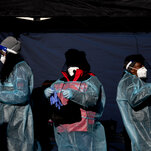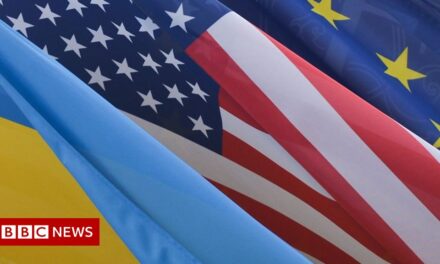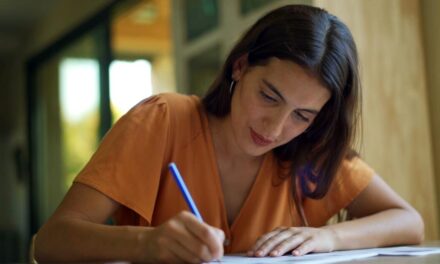
Covid-19 Live Updates: Advice Is on the Way for Americans Who Are Vaccinated

The Centers for Disease Control and Prevention is expected this week to issue eagerly awaited guidance regarding how or whether Americans vaccinated against the coronavirus may set aside restrictions adopted to slow its spread.
More than 30 million people in the United States — more than 8 percent of the population — are fully vaccinated, and many are wondering if it is safe to get together with friends and family, to travel or stop wearing masks, or to resume activities like going to gyms and restaurants.
“Those guidelines are coming out from the C.D.C. really imminently,” Dr. Anthony S. Fauci, President Biden’s chief medical adviser on Covid-19, said on Sunday on the CBS program “Face the Nation.”
He suggested that the recommendations could be issued within the next couple of days.
The new advice had been expected last week, but Dr. Rochelle P. Walensky, the C.D.C. director, said in a White House briefing on Friday that “these are complex issues, and the science is rapidly evolving.”
“Our goal, and what is most important, is that people who have been vaccinated and those not yet vaccinated are able to understand the steps they can take to protect themselves and their loved ones,” she added. “We are making sure and taking the time to get this right.”
The clamor for federal guidance comes as some governors have begun lifting state restrictions, despite warnings from health officials that it is much too soon and criticism from Mr. Biden that such actions represent “Neanderthal thinking.”
Last week, Texas and Mississippi, both Republican-led states, lifted statewide mask mandates. Restaurants have reopened for limited indoor dining in New York City. Officials in Connecticut plan to end capacity limits on restaurants, gyms and offices this month. In at least a half-dozen states, officials are insisting that schools offer in-person instruction for at least some grades.
“We need the country open,” Senator John Barrasso, Republican of Wyoming, where the mask mandate has not yet been lifted, said on Sunday on NBC’s “Meet the Press.”
“We need kids back in school every day with a mask, without a mask,” Mr. Barrasso said. “We know how to stay safe. We know what we need to do: get vaccinated.”
Asked if lifting mask mandates would inspire some people to stop taking protective measures, Mr. Barrasso, an orthopedic surgeon, said, “Well, people need to take precautions. I have my mask with me right here. I’m going to continue to wear a mask. And I think people will use good judgment to do so.”
On Sunday, Gov. Jim Justice of West Virginia, who recently loosened restrictions on businesses but has kept the state’s mask mandate, said that other governors needed to be more incremental in lifting mandates.
“I don’t like the mask, either,” Mr. Justice, a Republican, said on CBS’s “Face the Nation,” adding that he believed the mandates were still necessary for probably at least another month.
“I have a saying — ‘one robin doesn’t make spring,’” he said. If Americans start to celebrate too early, he added, there will be consequences: “You’re about to get hit by a winter storm.”
There is still some scientific ambiguity around which behaviors are safe for people who have been vaccinated. While the vaccines are highly effective at preventing serious illness and death, there is not yet sufficient evidence on whether vaccinated people may still transmit the virus to others.
Dr. Michael Osterholm, director of the Center for Infectious Disease Research and Policy at the University of Minnesota, said on Sunday on “Meet the Press” that it was important that the C.D.C. issue guidelines that are pragmatic and recognize the conundrums faced by Americans trying to navigate a society in which some people are vaccinated while others await their turn.
“If we just tell people that they’ve got to stay cocooned, that they’ve got to stay in their homes, that they’ve got to continue to wear their masks, even though they’re fully vaccinated — they’re not going to do that,” Dr. Osterholm said. “They’re going to disregard the public health recommendations, so we have to get real.”
The guidelines should address questions like whether grandparents who are vaccinated can see their grandchildren, he added. And the recommendations should distinguish between activities that might be relatively reasonable for vaccinated people and those that should still be off-limits, like going to crowded restaurants.
As of Sunday, Biden administration officials were still urging American communities to maintain precautions until more progress had been made.
“We just need to hang in there a bit longer,” Dr. Fauci said. “We will be pulling back on these mitigation measures. It’s not going to be this way indefinitely, for sure.”

About 58.9 million people in the United States have received at least one dose of a Covid-19 vaccine, including about 30.7 million people who have been fully vaccinated. If you’re one of those people, you may be wondering what you can and should do now. The vaccines are powerful, but scientists warn that even vaccinated people shouldn’t drop their guard until more is known about them. Here are some answers to a few common questions.
Am I immune right away?
It takes several weeks for your body to build immunity after vaccination, according to the Centers for Disease Control and Prevention. That means you won’t reach peak protection in the early weeks after your vaccination. For vaccines that require two doses, protection is typically achieved seven to 14 days after the second shot, infectious disease experts say.
If you’re receiving the Pfizer-BioNTech or Moderna vaccine — which require two doses three to four weeks apart — your first dose will provide only partial protection and you will need to receive the second shot.
Can I still be infected with the virus?
A Covid-19 vaccine will help protect you from getting sick, but you can still test positive for the virus. It takes a few weeks for your body’s immune system to become fully trained, and vaccines don’t offer perfect protection.
Clinical trials showed that the Pfizer vaccine has an efficacy rate of 95 percent in preventing Covid-19 and the Moderna vaccine has an efficacy rate of 94.1 percent after the second dose. The one-shot Johnson & Johnson vaccine has an efficacy rate of up to 72 percent.
Do the vaccines protect against the new virus variants?
New, more contagious and possibly more lethal virus variants are spreading in the United States. While Moderna and Pfizer said their vaccines were effective against the variant first discovered in Britain, some shots are less protective against the variant in South Africa. The Johnson & Johnson vaccine had a 64 percent efficacy rate in South Africa.
Vaccine makers could update their shots if needed to provide better protection against variants. Moderna has already shipped its new vaccine, designed to strengthen protection against the variant found in South Africa, to the National Institutes of Health for clinical study.
Can the vaccine make me sick with Covid-19?
No. None of the three vaccines in the United States contain the live virus that causes Covid-19, so they cannot give you the disease, according to the C.D.C.
Can I pass the virus along to someone else?
Scientists are still learning how well the vaccines prevent people from spreading the virus. In the interests of speed, vaccines were designed primarily with the goal of preventing severe illness and death, not stopping transmission of the virus. But the limited research so far has shown promise, and experts say they’re confident that the vaccines reduce transmission. Still, it’s unclear how effective they are in the nose and throat, where transmission is driven.
Do I still need to practice social distancing and wear my mask?
Yes. Public health officials recommend that vaccinated people continue to practice social distancing and mask wearing in public spaces. Especially in the early weeks after getting fully vaccinated, when you’re still vulnerable to catching the virus, you should keep wearing your mask.
You may be fully vaccinated, but millions of others remain unprotected and it’s unclear how effective vaccines are at stopping the spread of the virus. The C.D.C. is expected shortly to issue new guidelines on small gatherings of vaccinated Americans.
What side effects can I expect?
Common side effects include a sore arm, fatigue, headaches, chills and muscle pain. Data from clinical trials and anecdotal reports show that side effects can be worse after the second dose for the Pfizer and Moderna vaccines. Side effects can be unpleasant, but they typically last about a day and they’re a good sign that your immune system is responding to the vaccine.
The Johnson & Johnson vaccine appears to cause milder side effects than the Pfizer and Moderna vaccines.
Will I get a certificate saying I am immune?
You should be given a card that tells you which vaccine you received, the date you received it and the location of your vaccination. Officials recommend that you keep this card in case you need it later. Vaccine passports — government-issued cards or smartphone badges that serve as proof of vaccination — have raised ethical questions. Dividing the vaccinated and unvaccinated could give privileges to communities that tend to be white and well-off.
Israel became the first to roll out its own version last month, and several European countries could soon follow. President Biden has asked federal agencies to explore options.
How long am I immune?
Scientists aren’t certain how long immunity induced by vaccines may last, but early evidence suggests that even natural immunity may last for years. Still, the new variants surfacing around the world may change the calculus.
Some of them, including variants first identified in South Africa, Brazil and New York, seem to dodge the body’s immune response, weakening the protection conferred by vaccines. There are reports of people who have recovered from infection with original virus being infected with a variant.
Scientists had not expected the coronavirus to develop so-called escape mutations so quickly, and Pfizer and Moderna are investigating whether third booster shots may be necessary.
I got the first dose of a two-dose vaccine, and a few days later tested positive for the virus. Should I still get the second dose?
You should still plan to get the second dose, but check with your doctor. The C.D.C. recommends that people who had Covid-19 should still get vaccinated because experts don’t know how long natural immunity lasts. Some studies suggest, though, that a single dose of the vaccine may be enough for people who had Covid-19 and recovered.

In Alaska, where the Indigenous population has been ravaged by global disease outbreaks for generations, the pandemic has killed Alaska Natives at quadruple the rate of white residents.
The virus has taken hold in remote communities, setting up an urgent race between infections and vaccinations during a season in which weather can limit travel, the sun may only wink above the horizon, and large, multigenerational families are crowded indoors.
When the pandemic began a year ago, Alaska’s isolation was an asset that provided villages an opportunity to set up lockdowns, testing requirements and controls on travel.
But as the virus has slowly seeped across the state, the rising infections have demonstrated how quickly isolation can turn into a liability. In Pilot Station, a 37-year-old man died after weather prevented a medevac plane from reaching him. The virus has raged in some communities that have minimal sanitation, in some cases infecting more than 60 percent of residents.
Yet thanks to the steady supply of vaccines available to Native Alaska tribes and a sprawling delivery effort involving bush planes, boats, sleds and snowmobiles, 16 percent of the population has received a second dose of the vaccine, the highest in the nation. One of the regional operations, Operation Togo, harks back to the grueling 1925 sled dog run that rushed diphtheria antitoxin across the state to an outbreak in Nome.
The villages also have resources they lacked a century ago, when the 1918 flu wiped out more than half of some communities. A network of tribal health aides provide frontline health care and critical testing, treatment and telemedicine links with faraway hospitals — a network being considered for replication in the Lower 48.
But with the vaccine, there are extra challenges: Health crews must coordinate flights out to villages and arrange for someone to pick them up at the runway by vehicle or snowmobile. They need to make sure someone has started up the wood stoves to warm up the tribal halls where shots will be administered.
One team recently landed in a village as the temperature hit 61 below.


















